
MAY CONTAIN NUTS

Search Shorpy
SHORPY ART

Framed or unframed, desk size to sofa size, printed by us in Arizona and Alabama since 2007. Explore now.
Join and Share
Ad-Free Shorpy
Shorpy is funded by you. Patreon contributors get an ad-free experience.
Learn more.

Recent comments
- Complicated then, forgotten now
- Bryan-Stevenson
- Skinny is as skinny does
- How do you rest in peace
- Riding the footboards
- Alas, hidden from view
- Baldwin Diesels
- Exclusive pump
- Bananas, Oysters and Smokey Joe
- Details, Details
- What's that building to the left of the tower?
- Coal Barges
- Bromo-Seltzer
- Inner harbor
- The Basin
- What a headache!
- Giant stepladder?
- Yeah, it was cold
- Love those coats
- Link & Pin Days Remnant
- Baldwin 62303
- Baldwin VO-1000
- Cold
- No expense spared
- Tough Guys
- What's your hurry, where's your hat?
- Sheriff's Signature
- Relocated in the Eighties
- Lost in Toyland
- And without gloves
Member Photos
The Shorpy
Print Emporium
Print Emporium
Search Shorpy
Search results -- 30 results per page
- Halloween Party: 1938
- ... for migratory agricultural workers." Acetate negative by Dorothea Lange for the Farm Security Administration, and Happy Halloween from Shorpy. ... Posted by Dave - 10/31/2022 - 12:10pm -
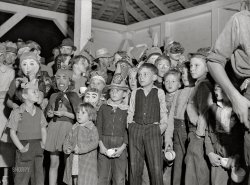
- Party of Four: 1956
- ... disagree. I love the family pics. Sometimes I find the Dorothea Lange types depressing.
Also, Did Billie Holiday sing "The Thrill Is Gone"? ... Posted by Dave - 11/25/2021 - 5:10pm -
![Party of Four: 1956 As a follow-up to yesterday's Pastel Princesses we present a retinue of possible Princes, or maybe court jesters, at what looks like the same event. Live it up while you can, boys. 35mm Kodachrome from the "Linda" slides. View full size.
Ma!Have you seen my red socks? I'm late for the dance!!!
The Cast of "Diner"The Early Years.
The charm and uniquenessof Shorpy is, in my opinion, somewhat diminished by the inclusion of family Kodachrome snapshots. I still make my daily visits, but—as Billie used to sing—the thrill is gone. Am I alone in thinking so?
A little dab'll do yaCheck out the hair tonic stain on the walls.
You may not be aloneIn your finding your viewing pleasure diminished, but I'm sure that you are outnumbered 1000 to 1.
I think these two last dance photos show the old saying to be true. Girls mature faster than boys. And not just physically.
Wider visionI am one of the many who finds that "the charm and uniqueness of Shorpy" is in no way diminished by the inclusion of photos from family collections of the past 50 years. Considering Shorpy as the place of photos only a century old, or exclusively black and white, is an unnecessary limitation. It's much easier to see it as repository of so much more. Broaden the vision, Chris Albertson, and let yourself settle comfortably into the range and variety of what Shorpy has to offer. It won't hurt a bit.
Pocket squareIf only we could see what those blue and white ticket/program things are in both of these pictures. At first I thought it was the same guy but they have different ties (and ears!). I love these candid snapshots.
[He might be the boy with his back to the camera in the other photo. - Dave]
Love It AllI love seeing these smiling boys who seemed to have left their dance dates to wonder where they went.
I'm a fan of every genre of Shorpy pic. Yes, I'm partial to ones showing old houses because we're restoring a Victorian and become enthused over clapboard, millwork, and knob and tube wiring, but I like the other pictures, too.
You're alone, ChrisViewing glimpses of the past, whether 100 years or 50, is fascinating.
My wife would tan my hide!Red socks, especially with blue slacks? I would never live that down.
As for the inclusion of family Kodachrome slides, I enjoy them. The reason I like Shorpy is because it gives a glimpse of times past. Sometimes the family photos do a better job than some of the sterile professional photos.
The enrichment of ShorpyChris Albertson, a couple of years ago, I had the same opinion that you have now. I became annoyed by the postings of tterrance, but still maintained my daily visits. I am just 3 years younger than you, and have slowly realized that these more modern pictures are part of Shorpy's growth and our own past. Let's hope that some viewers will put names to some of these eBay finds. Respectfully, Urcunina
Interesting comment Chris, Hi Chris,
As a genealogist and family historian, I found over the last few years that Shorpy was an invaluable historic resource for my research. Sure, i would "surf" anonymously but that was that; got my info and off I went. But some days I would just look 'into' places. Literally, zoom up and into the lives of the residents of the cities and neighborhoods featured here. I just couldn't believe where these images would lead me. The most interesting stories and facts and especially the comments. Regular folks, not necessarily experts, just interesting folks. It was these "folks" who drew my attention more and more. I agree that historic and/or "slices in time or life" images seem to be the most engaging, but these Kodachromes are most definitely part of photographic history. They are indeed unique imagery. They are historic AND deteriorating very quickly in drawers, closet shelves, carousels buried in garages and scattered in boxes in attics around the world. When one of these gorgeous images is posted and you begin to read the story and see the real living color of a time gone-by and the comments pour in and you peek at the numbers and see thousands (!!) of "reads", well you gotta feel some excitement and thrill of the "get". Just figuring out the puzzle of a time and day just out of memory or reach for many of us, or the makeup of an interesting family from New England, well it's like a treasure hunt. And aren't those so much fun? It is admittedly a great and grand waste of time I suppose, but most certainly, the best fun since Facebook launched 9 years ago, and quite possibly new beginnings for these images and their owners. For me and my extended family, sharing our Kodachromes is a tribute to the family members (many already gone) who took the time to lug a bulky, clunky, camera around and set up and snap a pic for us all to enjoy just a couple of times on the dining room wall. Now we are really enjoying them again, along with a surprisingly large number of people. It just feels wonderful. I hope you will continue to enjoy the historic quality of these beautiful images as well as the amazing resources from the LOC and Detroit Publishing etc... But please most of all, I hope that you also appreciate the men and women that are working literally 24/7 on Shorpy.com (not to mention all those folks sitting at home, eyes glued to the screen, mouse at the ready) bringing these images to us all day and all night. They ARE Shorpy.
Regards, Deborah
CharmingI actually do enjoy the family snapshots. It's great fun to look at what people were doing in their everyday lives. Shorpy has it all!
re: charm and uniquenessI have to disagree. I love the family pics. Sometimes I find the Dorothea Lange types depressing.
Also, Did Billie Holiday sing "The Thrill Is Gone"? I always thought it was BB King's song, didn't realize it was a cover.
Diminished? Not at all.I think these Kodachromes are as valuable to Shorpy as all the other historical pictures. Where else do you see unknown people, photographed by unknown photographers, in unknown places, and hope that there will be the one comment:
"OMG that's me taken by my uncle Bill at our junior sock hop."
It will happen.
100 years from nowthese sort of photos will be just as fascinating to people as any of the older, more "serious" examples on Shorpy. Every moment is history as soon as it passes. How lucky we are that occasionally, someone catches it on film, or video, even digitally. It's all wonderful and so is Shorpy!
I can see what Chris is sayingI think the Kodachromes are either hit or miss. Some I enjoy while others (the majority) I could do without. But I don't run the site and I can't complain if I don't find a particular image interesting because there are more than enough images on here to keep my occupied.
The site as a whole is really unique. And one should keep in mind that "beauty" is in the eye of the beholder. Ergo, an image that might delight one viewer is sure to bore another.
No Smoking?But there appears to be a pack of smokes on the ledge of that little window.
Also, count me in as one who really enjoys this type of photograph, then again I collect other peoples old home movies so I'm biased.
These are every bit as interesting as the LOC type of photo and probably a more realistic slice of Vintage American life since many of the LOC pictures are staged to some extent.
The overwhelming response to my postis appreciated, but it also made me sort of analyze my own expressed opinion.
I think it boils down to the fact that I have so many family Kodachromes of my own and such snapshots are readily found on the internet. Shorpy's more regular fare, those wonderful old photos and the remarkable clarity achieved by tterrance and crew are not as easily Googled and rarely presented with such sharp details. Then, too, I am 81 and a jazz historian, jaded by having hundreds of photos around the apartment.candid shots from the 50s on up bring back memories to me, but not the discovery that makes Shorpy so speciale. So, I guess I have been spoiled by the delights of Shorpy. I still love this site and recommend it (one of my two blogs has had a Shorpy link for three years).
Thank you all for the comments and thank you tterrance for the site and this forum. I hope I haven't been too disruptive.
P.S. Yes, AuntieVi, BB King certainly made "The Thrill is Gone" his own and turned it into a hit. I heard Billie sing it in person, but I don't think she recorded it.
RegardlessOf the photo, black and white or superb color, recent or ancient, they are glimpses into our past and help us visualize, if only for a moment, what life was like back then. And in some cases, see ourselves as we were. Love to know where those stairs went up to, obviously some sort of service stair based on appearance, why was the access open to them. This band of merry makers look like they'd be just the ones to sneak up and create a ruckus.
AshtrayUnderneath guy on right, with smoldering cigarette. (Hey, they're not in the main hall but in the shenanigans room. There's one in every building when you're a teenager.)
Charming and uniqueThat's what the guy third from left believes about his choice in socks.
Is That a Ceiling on the Wall?I guess the tin fits everywhere kind of like this mix of photos fits throughout Shorpy. I enjoy all the ages presented especially if you can see that other generations were just as squirrelly as mine no matter what the social norm.
Re: Lincrusta. Thanks Mattie, that's interesting and makes sense. Cheaper than wood molding and less fragile than formed plaster. I think it does need a paint adhesion inspection if possible.
As per Chris AlbertsonNot to jump on the wagon or anything, but I have just now joined the site after a year or so of browsing to offer the following comment: not all of your viewers are camera aficionados steeped in the history of photography or, dare I say it, of an older generation. I am no spring chicken, having been born in the late 1970s, but almost every single photograph on here predates me and I learn from and enjoy seeing all of them, family Kodachrome snapshots included.
Not diminished at allI love this site and don't see the inclusion of Kodachromes as diminishing it at all! Keep up the great work!
No spring chicken?Orange56, I sincerely hope you don't feel "over the hill" at mid-30's! Chris Albertson has a little fewer years on me, than I do on you; you've got a long way to go, youngster!
Everybody and their uncles"The thrill is gone" was recorded by mostly every pop and jazz singer in that era. Julie London, Peggy Lee, Ella Fitzgerald, Sinatra, Tony Bennett, Mel Torme and on and on. (I don't think Michael Bolton has recorded it yet but he probably will...I'm kidding about M.B.) Critics like to give him a hard time, so I'm piling on too.
These old KodachromesI like that they've been included. My parents would have been approximately this age in the early fifties and I enjoy seeing what life was like in a unrehearsed kind of way.
Ceiling on the wallIt's a heavily-textured wallpaper known as Lincrusta or Anaglypta. It's sturdy stuff and can hold up well under layers of paint. If we knew where this building is located, we might learn how well it holds up under layers of hair tonic.
More color Kodachromes!!!I love the 100 year old b/w photos, but the color Kodachromes make Shorpy a much more "thrilling" site for so many more people. Keep them coming...even up to the 70's & 80's. They are necessary to keep Shorpy relevant to a larger population of internet users.
Fuggedaboutit!My first (and second) thought on this photo is that it looks like some of the gang from "The Sopranos". It's a little before their time, but I still see it every time I look at this photo.
Farked!https://www.fark.com/comments/11937855
(Farked, Linda Kodachromes)](https://www.shorpy.com/files/images/SHORPY_Linda147.thumbnail.jpg)
- Route 99: 1939
- ... he once lived there.'" Medium-format nitrate negative by Dorothea Lange for the Farm Security Administration. View full size.
Tough ... Posted by Dave - 05/21/2012 - 10:50pm -
![Route 99: 1939 February 1939. "On U.S. 99 near Brawley, Imperial County, California. Homeless mother and youngest child of seven walking the highway from Phoenix, Arizona, where they picked cotton. Bound for San Diego, where the father hopes to get on relief 'because he once lived there.'" Medium-format nitrate negative by Dorothea Lange for the Farm Security Administration. View full size.
Tough BeginningsThis baby would be somewhere between 73 and 75 today if she made it through those hardscrabble years and is still around. Hopefully life got better and she did experience more good times as the economy improved. I'd like to think there was sufficient joy in her life to bring about contentment and fulfillment as time went on. As for mom, as one elderly lady once told me "When your kids hurt, you hurt too." This mom's face does convey the pain of a struggle to take care of a family (as another child is visible in the extreme left margin) and reminds us that life is not always just a bowl of cherries.
[As noted in the caption, this lady had seven kids. - Dave]
Brawley=HotGood thing it's February, Brawley is nearly intolerable in the Summer.
Worn outThe baby is lucky to have shoes. My mother didn't own a pair until 1940 when she was 11. She picked a lot of cotton during the Depression too as a migrant worker in the Arkansas-Oklahoma-Texas border area. An interesting aside: In the late 1960s Mother asked us kids what "soul food" was. We told her. Her reaction was, "Soul food! That's poor people food and I've eaten enough of that."
Ummmm check on thisUS 99 never ran through Phoenix; it ran from the Mexican border in California to Blane, Washington. So she didn't walk US 99 from Phoenix as inferred in the note about the photograph. US 60 ran from the Arizona state line where it connected to US 70 to then connect to US 99. So she walked the highways, not highway.
Ms. Lange's unique styleShe never fails to reveal the deepest pathos of her subjects.
my heritageThis is what my grandparents endured as small children when they emigrated to California from Oklahoma and Arkansas.
Particularly SadThere is something uniquely sad about this obviously very poor woman wearing a worn fur coat. Does the coat imply she was in better financial position in the past? Was it purchased in a worn used state? One can only wonder.
(The Gallery, Dorothea Lange, Great Depression, Kids)](https://www.shorpy.com/files/images/SHORPY_8b33233u.thumbnail.jpg)
- Migrant Mother colorized, 1937
- This is the coloration of Dorothea Lange's iconic 'Migrant Mother' photo. The stark reality of Dorothea's original photograph is actuated by the addition of color, which I ... Posted by Kenny - 04/11/2017 - 2:30pm -
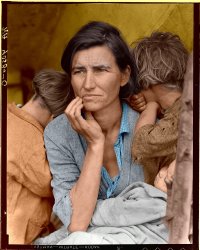
- Paging Edward Hopper: 1940
- ... and legendary photographers. Walker Evans. Lewis Hine. Dorothea Lange. Ben Shahn. Russell Lee. Look them up.
The photos are so detailed ... Posted by Dave - 09/07/2011 - 2:43pm -
![Paging Edward Hopper: 1940 Children in the tenement district, Brockton, Massachusetts. December 1940. Photograph by Jack Delano. View full size. These duplexes must have been fairly grand when they were new, probably around the turn of the century. They look like the house where Granny and Tweety Bird lived. Are they still there?
I'll get it running some dayEver since there have been cars somebody has put them on blocks and abandoned them.
Are you sure that picture isn't a model?Look at the people. They just don't look real. And neither does the car or the big tree limb in front of it all.
They are still there...I can't promise you that these exact ones are still around, but there are many that look just like this in Brockton. Some have been restored, some are still run down.
Sure it isn't a model?The people don't look real. The car looks like a toy, and the tree limb in front of it all is huge.
Tree limb??That's a telephone pole. Click here. Another version is here.
Telephone pole?Actually it is a power pole, there are no telephone lines on it. If you look real close you can see the telephone pole and lines in the back.
ever wonder?Ever wonder what the people's thoughts were at the moment the photo was taken? A. Moore
Re: Sure it isn't a model?I haven't poked around this site a lot, so maybe this info is here somewhere (yeah, yeah, I read the explanation of the Shorpy name) -- but maybe you should explain more background to a lot of these photos from the 30s and 40s.
Of course they're real.
These are by documented, well-known, and legendary photographers. Walker Evans. Lewis Hine. Dorothea Lange. Ben Shahn. Russell Lee. Look them up.
The photos are so detailed because they used large format cameras with honking big negatives.
http://xroads.virginia.edu/~UG97/fsa/welcome.html
Read the book Let Us Now Praise Famous Men. Get a hardcover copy that really shows off Walker Evan's photos.
And keep looking back here for more leads on great documentary photography.
Looks real to me.I'm loving those roofs. The shape is wonderful.
How pretty these homes must have looked when new.
This, and "American Gothic".I don't know if it's of any use, but if you look at the "American Gothic" image (another from this shoot), the number 22 is chalked onto the left door on the porch. Maybe somebody who knows Brockton (Dianne Cantara, where are you?) can track down this locale and tell us what's there now.
FantasticThese houses are fantastic.
Are they duplexes or quads? That's an amazing amount of house for a duplex!
Mansard RoofThere are many examples of this style of house where I live, I grew up in one very similar that had 4 single family homes in it, each of which is now at least 5 apartments. The roof style is a Mansard roof if I'm not mistaken and is fairly common in the Northeastern US and Canada, it stands up well to a heavy snowload.
Mansard RoofThe mansard roofs and style of these houses is called the French Second Empire style. In the last half of the 19th century, it was common to have roofs with dormers. It provided an extra residential floor, but tax assessments did not count the top floor in the market appraisals, so owners were, in effect, adding a floor to the building without being taxed for it. This was explained to me by a historian who recently gave a wonderful two-hour walking tour of houses and mills along the Quinebaug River in Putnam, Connecticut. You can see some interesting information about this at:
http://www.americanlandmarks.com/french.htm
They are there!I grew up in Brockton and those places are still there!
Brockton, Mass.Would anyone please post the address of the location this shot was taken? I am working on a photogray project where I am shooting with a similar vision as Edward Hopper paintings. These Mansard Roof homes would be perfect subject matter at sunrise/sunset.
Oh, please forward the address to my e-mail at sternedwards@aol.com
Thanks In Advance,
Charles Roland
1932 Ford Standard TudorThe car is a 1932 Ford Standard Tudor and the color is Washington Blue. I have one just like it.
Look at the detailsI see details such as the fading wreaths in the windows, the rain downspouts that have a "Y" connectors from the second floor roof to the bay window roofs, then to the next level and then down to the ground; the corbels in the entry way. So many homes had them as trim items and so many are removed today. A lot of architectural character is missing in today's homes.
Is it totally genuine?The power pole looks fake at the base, and its shadow is narrower than the pole itself. And take a look at the shadow of the child in black: different angle. The dog ... oh well ... no shadow at all. Maybe not totally fake, but surely retouched.
[The shadow of the pole would be the same width as its base if you could see where two the came together behind the where the dirt has built up along the pavement. The shadow on the ground next to the kid is cast by whatever he's holding; his own shadow is much smaller, like the dog's. - Dave]
(The Gallery, Brockton, Cars, Trucks, Buses, Dogs, Jack Delano, Kids)](https://www.shorpy.com/files/images/1a33854u_0.thumbnail.jpg)
- Family Trip: 1939
- ... View full size. Medium-format nitrate negative by Dorothea Lange for the Farm Security Administration.
Can we assume... the young ... Posted by Dave - 03/02/2012 - 10:41pm -
![Family Trip: 1939 August 1939. Agricultural migrants. "Family who traveled by freight train. Toppenish, Washington. Yakima Valley." View full size. Medium-format nitrate negative by Dorothea Lange for the Farm Security Administration.
Can we assume...the young child on the right is the "feeling low" Ms. Toppenish captured by Dorothea before or after this photo?
Denny Gill
Chugiak, Alaska
Migrant FamilyI was born in the month and year this photo was taken. While my family was by no means affluent, we had it good compared to this family and countless others across the country. We had a roof over our heads, coal to heat, and food on the table. It's humbling to see photos like this.
Despite the hard times this family is evidently experiencing, the little boy seems perfectly content. He's found a stick to play with, like little boys do.
His mother, on the other hand, seems to be thinking, "What will we feed these children tonight?"
Re: My GrandfatherGood for your grandfather! If I had been running the train, I would have stopped the engine to allow a family like this to climb aboard. Why not? It's not like the railroads were losing any money by hauling people in an otherwise empty boxcar. Liability issues, no doubt. But would any of these people have been likely to hire a lawyer and file a lawsuit?
Look at the trains in India: wall-to-wall people, sitting atop the cars, hanging out the windows and off the sides.
"May I see your ticket, please?" No way.
I was also born in 1939, andI was also born in 1939, and raised by an almost-illiterate widow. She made good use of her "widow's mite' however, so that we had a modest house, an old car, food at mealtimes, and heat (one of my chores as an adolescent and teen was fire-tender). While we had no books, magazines, or newspapers in the house, I was nevertheless encouraged constantly to go to school and get as much out of it as I could. While she might be disappointed that I never quite got the bachelor's degree, she would be delighted if she could know the level of affluence I have reached today.
How does this relate? Well, one wonders to what extent this picture shows the result of bad luck or whether it is due to poor choices.
Shoes Don't MatchLook at Dad's shoes - a mixed pair, I think. They may not have been a good fit; he's letting his dogs breathe without them.
RE: "poor choices" - the U. S. unemployment rate in 1939 was 17.3%, compared to about 5% today. Maybe their "poor choice" wasn't a choice at all, but simply because they were part of that unfortunate 17.3%. It would take almost two years from the day this photo was taken for the wartime economy and the draft brought the U.S. economy to almost full employment.
[Below, a comparison of styles then and now. - Dave]
My GrandfatherWas a migrant farm worker when he was in his teens in the early 30's. He (somehow) convinced the Chicago, Rock Island, and Pacific Railroad to hire him on as a fireman in 1936 on his 18th birthday.
He always refused to throw hobos off the train and during the cold winters of Illinois and Missouri he'd let women and children have his seatbox in the cab, he often received demerits for his humane treatment of those he only recently rose above.
Optical IllusionI think I was mistaken. Dad's shoes are a pair. I guess it's all a matter or perspective.
Goober Pea
The KidWhile it can be a tough call, the child on the right appears to be a boy, no? And the wingtips in Feeling Low do not match the plain shoes in Family Trip, fwiw...
MotherI think that generally mother here is the only person that's not content with the situation. I also think she was the only person here who didn't want this photo to be taken.
MoralsThe father at least didn't abandon the family and set off on his own. Could we say the same for families today. No, I think either the mother would dump the guy and go on welfare or the guy would run off to start a new life. This shows how family morals have changed over the last 75 years.
I'd stop the engineMy Father-in-law came from a "RR" family and from the way he described it you would not stop if you wanted to keep your job.
It took 30 years of service to earn a pension, you could get 26/28 years no problem, it was the last 3or4 that were very hard. He said they watched you like a hawk any misstep and you were fired ,so no I don't think you would stop.
Riding the rails...My grandfather was part of an obscure local railroad -- Indianapolis Union Belt, which eventually became part of Conrail. Back in those days, jobs were hard to come by and they followed the rulebook quite seriously. The "bulls," as he called the railroad police, were notoriously cruel to hobos and to people who had a soft spot for them. They were a clique that didn't hang out with the rest of the workers.
Hard Travellin': The Hobo and His HistoryI recently read "Hard Travellin': The Hobo and His History" by Kenneth Allsop. Anyone interested in the story of homelessness, migrant workers, hoboing, the roots of the labour movements, etc., should read it.
(The Gallery, Dorothea Lange, Great Depression, Railroads)](https://www.shorpy.com/files/images/8b34311u_3.thumbnail.jpg)
- The Happy Camper: 1938
- ... Camp, California." Medium format nitrate negative by Dorothea Lange. View full size.
How proudly downtrodden It's interesting ... Posted by Dave - 07/24/2012 - 7:14pm -
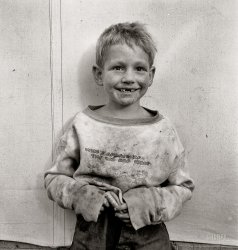
- Short Term Parking: 1936
- ... Some houses have plumbing." 4x5 nitrate negative by Dorothea Lange for the Resettlement Administration. View full size.
Car ID ... Posted by Dave - 10/18/2022 - 1:57pm -
![Short Term Parking: 1936 February 1936. "Mexican quarter of Los Angeles, California. Houses condemned to make space for the new Union Station. Average rental eight dollars. Some houses have plumbing." 4x5 nitrate negative by Dorothea Lange for the Resettlement Administration. View full size.
Car ID suggestionsLeft row front to back: Buick, Buick (29-31 era); 1932 Ford V8; 1933 Chevrolet Master; 1934 Ford V8 and 1924 Chrysler. Middle row: 1927 Chevrolet in front and unknown in back. Next row: 1934 Ford deluxe V8 and hidden last is a Model A Ford Tudor. Nicely maintained collection in a tidy lot.
Plumbing optional, rats freeHard to imagine living in a place like this today, but back in the '30s the rats were friendly.
Of course, I'm confusedEight dollars in 1936 is about $120 today. Was that per week or month? [Per month. - Dave] I hate to think of what the tenants who didn't have plumbing did with the water they needed to dispose of. I'm pretty sure there were times this parking lot did not smell good. And why was a parking lot that's filled with fairly new cars needed here, next to these slums?
The part of the flag I can read says, Hoegee. I found a Wm H. Hoegee Sporting Goods Co. in Los Angeles in 1908 and they occupied a three-story building; but their address at 138 S Main Street put them a little over half a mile away from the new Union Station site.
I'm surprised dwellings this dilapidated have such sturdy looking stairs.
Old ChinatownThis area was one of several Chinatowns in the DTLA area, and was in fact the oldest. By the '30s it became more diverse with an influx of Latinos.
Here's a super-duper well done story about it.
Yep, a little off there, I'd sayMr. Floor Plan has presented just enough intrigue for me to go down this rabbit hole.
I found the same reference to the Wm. H. Hoegee company at 138 S. Main, and further, found this photo, which purports to be taken "from about the intersection of Los Angeles and 2nd streets looking northwest". Note the Wm. H. Hoegee Co. building, lower left and center. If accurate, this would indeed be where you'd expect to find 138 S. Main St.
NOW, compare that building to the one in Lange's photo ... appears to be the same height, w/ same window style and parapet roofline.
Which might also explain the presence of fine automobiles, being in a fancy downtown commercial district rather than the, er, more "modest" neighborhood to the north.
I believe in Ms. Lange's likely extensive Los Angeles travels that day, she may have gotten a bit confused about precise locations by the time these came out of the darkroom.
[Perhaps she's not the one who's confused? The city's "Mexican quarter," aka Sonoratown, was in downtown LA. - Dave]
(The Gallery, Cars, Trucks, Buses, Dorothea Lange, Los Angeles, Railroads)](https://www.shorpy.com/files/images/SHORPY-8b27070a.thumbnail.jpg)
- Dead Ox Flat: 1939
- ... Malheur County, Oregon." Medium-format nitrate negative by Dorothea Lange for the Resettlement Administration. View full size.
Been there ... Posted by Dave - 07/30/2012 - 2:44pm -
![Dead Ox Flat: 1939 October 1939. "Mr. and Mrs. Wardlaw at entrance to their dugout basement home. Dead Ox Flat, Malheur County, Oregon." Medium-format nitrate negative by Dorothea Lange for the Resettlement Administration. View full size.
Been thereMy grandparents used to take my brother and me on road trips out into the Oregon desert in the '70s. Can't say I've seen this particular house, but I can say it's spectacular but forbidding land -- what a place to eke out a living in those days! I almost stepped on a rattlesnake curled up on the sunny front porch of a cabin we stayed in.
White lightningNote the whiskey jug with the cork in it. More appropriate in this context than, say, a case of Dom Perignon, right?
I'd give anything...please tell me you have a photo of the inside of that thing!....Thanks Dave..Um, I hope you didn't take me seriously about the "I'd give anything" bit.
[Click here. - Dave]
TwinsI guess it's true what they say: the longer you're married the more you start to look alike.
StrengthThis is an outstanding photograph. It shows the strength, cheerfulness, and determination of our ancesters that settled this country. Great it is that this photo was taken in 1939.
Doug Santo
Pasadena, CA
Color Their WorldThis is one of those few old-timey pics that would look better in color.
It couldn't look worse.
Waste not want notEven that worn out tire has been cut up and used for something.
banderboy: I almost had an original thought.
Optimism neededTo live in a place named like that ...
Dead Ox : no explanation needed there
Malheur : french word for misfortune or tragedy
Oregon : comes from the french word "ouragan" (hurricane)
Waste notI wonder what he did with the rest of the old tire behind the milk cans.
ps: Geezer- great minds and all that...I swear there were no comments up when I wrote that!
Previously on Shorpy ...Also seen here and here. With an interesting note from Scott Wardlaw in the comments.
Motel 6I believe this humble home may have been the inspiration for the Motel 6 franchise. And as Mrs. Wardlaw used to say, "we'll leave the light on for you".
Small worldAs soon as I saw the caption of this picture I thought, "I wonder if my Internet friend Scott Wardlaw is related to them." And lo ...
Glenn WardlawIn the photo in the comments, the boy at the table is the Wardlaw's son, Glenn. There is a 2006 photo of him here:
http://www.hereandnow.org/2009/03/looking-at-dorothea-lange/
The DugoutThe photo seems to show an albeit flimsy ground level building or buildings trailing off to the rear. Is there a reason that folks like them would prefer living underground vs fixing up those sheds as living space?
[The structure to the rear is the top of the dugout. Pit houses were at one time common in the West and Southwest. - Dave]
The rest of the storyThis photo says so much with so little. More here in a comment from Noel Wardlaw.
Little House In the PrairieMy father grew up in such a basement house in Indiana in the 1940s and 50s. He had 10 brothers and sisters, so 13 of them lived there. He left the day he turned 18.
Oregon OriginFYI, the real origin of the name "Oregon" is unknown. It's first known use was in 1765 - http://www.oregonlink.com/namingoforegon.html , quite some time before French Canadian Trappers were in the area to get the meaning from there.
There is some speculation that the word was gotten from Indians living around the mouth of the Columbia River during that time, but if so the tribe and their dialect were gone by the time Lewis and Clark showed up.
(The Gallery, Dorothea Lange, Great Depression)](https://www.shorpy.com/files/images/8b35208u.thumbnail.jpg)
- Society of Friends: 1939
- ... Flat, Malheur County, Oregon. View full size. Photo: Dorothea Lange.
Dugout Why is the church underground?
The Facilities Check ... Posted by Dave - 09/08/2011 - 2:21pm -
![Society of Friends: 1939 October 1939. "All the members of the congregation. Friends church (Quaker)." Mrs. Wardlow and Mrs. Hull are over to the left of the entrance to the dugout. Dead Ox Flat, Malheur County, Oregon. View full size. Photo: Dorothea Lange.
DugoutWhy is the church underground?
The FacilitiesCheck out those outhouses! I can never see an outhouse without thinking of the spiders and creepy crawlies that lurk inside, waiting to drop down some unsuspecting victim's blouse.
Twister ProtectionClearly one can see the advantage of that in the event of a tornado. I don't think they have too many of those in Oregon, though.
Society of FriendsSociety of Friends is the formal name of the Quaker religion. Most of these people, Mrs. Wardlow and Mrs. Hull included, lived in dugout structures similar to the church.
Mrs. Hull!She's lovely.
Seems strange that folksSeems strange that folks would go down below to go to church as opposed to going up to church. I'm just kidding
I think I saw a show aboutI think I saw a show about that town on The History Channel or PBS - or rather about the man who made all of those photographs. I can't recall why the town was made that way though.
["The man who made all of those photographs" was a lady named Dorothea Lange. - Dave]
Ancestors in this PhotoSix of my ancestors are in this photo. They misspelled our last name as Wardlow, it's Wardlaw. Both of my fathers grandparents are pictured here as well as my great aunt and uncle. My father's father's parents (great-grandparents) Everett and Eva Wardlaw are on the left. She is the short lady with white hat and coat. Her husband is directly behind her. My father's mother's parents (again my great-grandparents) are the second couple from the right, Truman and Esther White. She is wearing the long black coat holding the Bible. Their son (my grandmother's brother) Leroy White is just right of the door. His sister (my grandmother's sister) is the lady wearing the black coat on the far left. My grandparents are not in this picture. My father was raised in this area of Oregon and we still have family there. This picture is in a collection in the Library of Congress.
(The Gallery, Dorothea Lange, Rural America)](https://www.shorpy.com/files/images/8b35186u.thumbnail.jpg)
- Pop Kola, Kolorized: 1939
- ... Brother of store owner stands in doorway." 4x5 negative by Dorothea Lange. Click here for the original B&W photo. View full size.
... Posted by Hille - 09/20/2011 - 8:27am -
![Pop Kola, Kolorized: 1939 July 1939. Gordonton, North Carolina. "Country store on dirt road. Sunday afternoon. Note kerosene pump on the right and the gasoline pump on the left. Rough, unfinished timber posts have been used as supports for porch roof. Negro men sitting on the porch. Brother of store owner stands in doorway." 4x5 negative by Dorothea Lange. Click here for the original B&W photo. View full size.
Fact or fiction?Do I now look at this photo with a different eye, I'm sure some of the colours are spot on, but I would think it a bit of a stretch on those fellow's shirts.
[I don't think that verisimilitude was the goal here. One reason why it's so striking. - Dave]
Danger in ColorSomehow I never took note of the men smoking in such close proximity to the gas and kerosene pumps, but it really stands out to me in color. Of course, if you escaped harm from any potential explosion, there was always the abundance of tobacco, one of the primary industries of NC. It looks like they were going to have to build a bigger store just to support the competition in advertising for tobacco in its various forms. I also like the way the mimosa branches in the upper left corner frame the picture in.
Thanks, DaveAnother trip to the olde Funk & Wagnall's to check the meaning of a word. "verisimilitude" indeed. This photo is extraordinary colourized. Thank you, Hille, well done.
Big difference.That is truly awesome seeing all those signs color! That would be a sign collector's dream to stumble upon a cache like this.
Great job Hille.
Rock Solid?What really jumps out at me with the addition of color are the "supporting" rocks that are holding up the front deck. Seems like one or two rocks could easily slide out and send that peaceful bunch flying.
Ouch!I made deliveries to this store in the late 60's and this is just wrong. Striking, but wrong. If verisimilitude wasn't the goal, there should be a lot more pinks, purples and chartreuses in there -- it wouldn't look much more unreal than this does, but a lot more striking.
[Talk is cheap! - Dave]
Don't I know it.
Like the Wizard of OzI've always enjoyed looking at these colorized photos. It helps me visualize how the world would have actually appeared to the photographer. I ran across a similar photo and colorized it a while back and am blown away how mine looks similar in color selection as this picture. See attached.
Summer of '39Wouldn't y'all love to have lazed along with this carefree group on that idle July afternoon listening to the neighborly conversation, the humor, the owner's dialogue, feeling the heat of a North Carolina summer, maybe hearing the cicadas buzzing, drinking cold soda, smoking cigs and best of all, NO technology, iPhones, texting, or headphones. People actually exchanging ideas, jokes, gossip, talking about their mates, perhaps discussing news about the Depression and the simmering war in Germany. Maybe some '30s music with some static emanating from a radio back inside the store somewhere, "watching the Fords go by," as my Daddy used to say. This was real leisure, my idea of the best kind of hanging out, an era gone forever.
Pure ArtI remember about half of the signage attached to the front wall. I can also remember the gas wars of the 50's when I pumped gasoline at 15.9 cents a gallon.
Beautiful job of coloring this photo, it's a shame the negative wasn't larger.
[The original is gigantic -- and even that's been downsized. - Dave]
Re: "Like the Wizard of Oz" submitted by skizmal"Like the Wizard of Oz" submitted by skizmal looks much more realistic to me. Those Chesterfield signs are just as I remember them, a very dark red, almost brown color. I'd love to see this photo larger.
What a difference colour makesI find that when I look at monochrome photos that were taken before colour photography was developed (pun intended!), after a while one gets to think of the pre-colour years as being totally colourless. Silly, I know, but that's the way the mind works.
So to see something like this -- and all the other colourizations presented here on Shorpy -- is really great. Thank you.
Re: Danger in ColorBased on my estimate (which probably isn't terribly accurate), I'd guess the guy on the left is about 6 feet away from the gasoline pump; and the guy on the right is about 3 feet away from the Kerosene pump. Due to the explosive quality of gas vapors, I'd be more worried about the guy on the left. Strangely enough, I still see people today; standing at a gas pump, puffing away. And even worse, they put the pump handle back in the cradle, and screw the gas cap back on with the same hand that's holding the lit cigarette. I figure that sooner or later, I'll be able to personally witness the next Darwin Award winner.
Uncriticisable!You have my utmost admiration! Truly a task of incredible patience and attention to detail!
Thanks for sharing this beautiful work!
Brown GasMy guess is that the color of the gas is too dark. Light amber would be more like it.
Just EnjoyWhy criticize! Just enjoy the picture as it is. Colors are not the same to everyone. I can remember seeing scenes just like this in rural East Texas. Thank you for taking me back in time. Ahhhh, the memories.
ColorGreat job on the color. The store reminds me of my grandparents' house in South Carolina. It was set on stones also.
Pop Kola:KolorizedThe Pop Kola titled pic is dead on, including the gasoline - if you've ever seen a large volume of leaded regular, you'd know that it looks much darker in quantity; there are at least 20, perhaps 25 gallons in that glass enclosure. BTW, anyone notice the shoe underneath the kerosene pump? All those guys appear to have theirs on.
(ShorpyBlog, Colorized Photos, Stores & Markets)](https://www.shorpy.com/files/images/Colorized_done2.thumbnail.jpg)
- Shave and a Shower: 1940
- ... from New Mexico and as many Russell Lee and Dorothea Lange photos as you can find.
535-07-5248 I always wondered where the ... Posted by Dave - 11/28/2020 - 1:19pm -
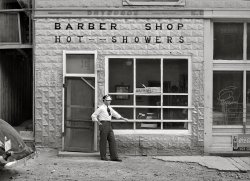
- L.A. Alley: 1936
- ... rent is eight dollars." 4x5 inch nitrate negative by Dorothea Lange for the Resettlement Administration. View full size.
Mysteries ... Posted by Dave - 10/20/2022 - 9:07pm -
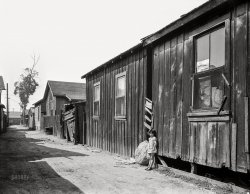
- El Tango: 1936
- ... will be torn down shortly." 4x5 inch nitrate negative by Dorothea Lange for the Resettlement Administration. View full size.
Planning ... Posted by Dave - 10/19/2022 - 5:40pm -
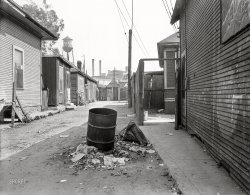
- Traveling Light: 1936
- ... en route and was abandoned." Medium-format negative by Dorothea Lange for the Resettlement Administration. View full size.
Wow, this ... Posted by Dave - 09/26/2012 - 12:27am -
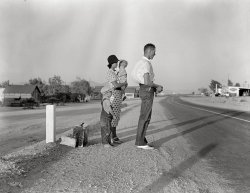
- Shoofly Hangers: 1939
- ... up strung tobacco inside the barn." Nitrate negative by Dorothea Lange for the Farm Security Administration. View full size.
Dirty Jobs ... Posted by Dave - 11/19/2022 - 3:38pm -
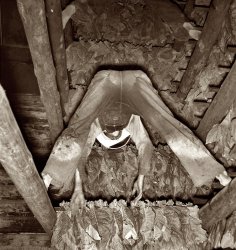
- Five Plus Pup: 1936
- ... two to seventeen years." Medium-format nitrate negative by Dorothea Lange for the Resettlement Administration. View full size.
Ah, I love ... Posted by Dave - 11/30/2009 - 10:52am -
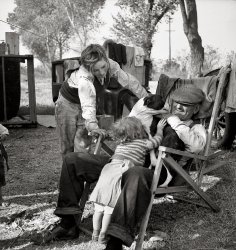
- Minivan: 1937
- ... family near Hazlehurst, Georgia." Nitrate negative by Dorothea Lange for the Resettlement Administration. View full size.
No ... Posted by Dave - 07/30/2012 - 2:44pm -
![Minivan: 1937 July 1937. "Sharecropper family near Hazlehurst, Georgia." Nitrate negative by Dorothea Lange for the Resettlement Administration. View full size.
No cupholdersObviously not needed!
Baby camouflageSurprised no one has spotted the feeding baby yet, its camouflage is working well.
[Somebody did. See the first comment below. - Dave]
Good mileage, but......what if the horse has gas?
Public BreastfeedingConsidering what a hot-button issue public breastfeeding is these days, when modesty standards are presumed to be looser, I find it interesting to see this mother willingly and happily breastfeeding her child in a photograph.
Granted, she is being what most would call "discreet," (and the baby's bonnet is rather amusingly functioning as camouflage), but interesting nonetheless.
Maybe she's wearyWomen do get weary, wearing the same shabby dress. This is one of those photos that speak a thousand words or more. Dire poverty, aged before their time, babies like steps, deprivation in every material thing. Yet they manage to smile for the photo (perhaps some coinage was in it for them)? Where does one begin to speculate on their needs? The kids appear to be freckled redheads but maybe not. How old do you suppose the parents really are? The children here may still be with us, but in a picture like this, one cannot help but be full of curiosity as to the austere circumstances and hopefully better outcome soon. Very thought-provoking photo Shorpy and makes everyone realize they were not so hard-up as previously thought.
Live HardCould that be Bruce Willis' grandfather? Because I sure see a resemblance. Also, nice camouflage idea, making baby's bonnet out of the same material as Mama's dress. What's with these Depression-era women, anyway? They're always flashing us.
Matching Baby BonnetThe patterned bonnet that matches the dress makes the breast feeding infant almost imperceptible. Dad's teeth help with the visual distraction, too.
Not Completely RagsI would guess this couple isn't much older than in their mid 30's. You age quickly in hard working conditions.
I grew up on the farm with not many luxuries. These people aren't exactly in rags for clothes. Who knows, they may have their best clothes on for this photo shoot. I've worn much worse when laboring as a kid.
That board as a seat sure doesn't look to comfortable though.
People:This is real.
Feed SacksThe dress and sun bonnet were probably made out of feed sack fabric. I suspect she had a bit of scrap material left and decided to make the baby a matching hat.
Feed sack fashions were VERY common during these times. Every girl had a dress made of them, nearly every boy had a shirt with at least some part of it sewn from them and everyone had a quilt made of the scraps. And we think WE recycle?
Longevity Petty good bet the parents are in their early thirties. I imagine they were sharecroppers. Unfortunately, they aged too quickly. I hope the kids did better.
PoignantOld before their time for sure. You can't tell, but her teeth are probably as bad or worse than his. They are doing a good job with their kids, they look well fed, as does their ox, but theirs was a hard life. Look at his nails. Great photo.
Tobacco RoadI finished reading the book recently. This is a stark reminder of life for the poor in our country in the 1920-30's.
(The Gallery, Dorothea Lange, Great Depression)](https://www.shorpy.com/files/images/8b32183u.thumbnail.jpg)
- Big Brother: 1939
- ... Valley, Washington. View full size. Photograph by Dorothea Lange.
Trash At first I thought these kids were playing in trash but ... Posted by Dave - 07/30/2012 - 2:39pm -
![Big Brother: 1939 August 1939. Migratory children living in "Ramblers Park." They have lived on the road for three years. Nine children in the family. Yakima Valley, Washington. View full size. Photograph by Dorothea Lange.
TrashAt first I thought these kids were playing in trash but when I looked again I realized it was a truck with their stuff on it.
TouchingA very protective stance.
[Indeed. Get away from us, Dorothea Lange! - Dave]
(The Gallery, Dorothea Lange, Great Depression)](https://www.shorpy.com/files/images/8b34297u1.thumbnail.jpg)
- Grace in Color: 1920
- ... of the brilliant photos by many documentary photographers (Dorothea Lange, Russell Lee et al) later came to be seen as high art, and rightly so. As ... Posted by Fredric Falcon - 06/26/2009 - 4:09pm -
![Grace in Color: 1920 A colorized version of this 1920 photo of actress Grace Valentine by the Bain News Service. View full size. More in the Colorized Gallery.
Color me impressedYes, great job. I still have my set of photo oils & pencils and have gotten good results from time to time. I've never really gotten the hang of getting the "right" look using photoshop.
CuriousIt would be interesting if we can find out, from Akvis, how many hits they get today and how many they would normally get. I visited the site just to see how it works, but I don't have many black and white photos.
A Fine JobA fine job of colorizing. It is interesting to compare the colorized photos in the gallery with the black & white counterparts. Would you share the name of the program you use for colorization?
Color or B/W, it still hurts to look at her feet.Nice colorization work and Grace was a stunner, but it still causes me pain to look at her misshapen tootsies. Ouch!! My 50 year old male feet with 30 years spent in steel-toed boots look healthier.
Akvis ColoriageThanks for all the compliments! I never expected my work would get such recognition here! The software I use is called Coloriage by Akvis. It comes as a standalone application and/or a plugin for Photoshop and many other photo-editing programs. The site has a short movie showing how easy it is to use.
Coloriage has a selection of colors for complexions, hair, eyes, lips, etc., plus wood, sky, water, fabric, bricks, and so on. You can save your color strokes if you want to exit the program and resume the coloring later. When you're ready to color the photo, just click one button and the job is done. You can load another copy of the same black and white photo, reload the saved strokes, and then change the color of any of them very easily.
And no, I'm not affiliated with the Akvis company at all nor am I being paid for these remarks.
Miguel Chavez asked how I know what color to give each pixel. I just use my intuition. It's all guesswork. I put on a color and then view the results. If it doesn't look right, I select another one. Sooner or later I get realistic colors. It's fun.
Was this photo taken...before the invention of the pedicure? That left foot looks like it needs a little TLC.
I used to colorize my black and white photos with Marshall oils, a slow tedious process, using Q-Tips and patience. Photoshop has changed just about everything I suppose. Yet this photo looks to either be hand tinted or slightly off due to the green hue on the lower edge of the seat slab. The blue pottery job is very nice.
Most impressive!I definitely must congratulate you on this fine job of colorizing these old pictures. It's amazing! they really look natural and unlike the hand-colorized photos I know, in these you don't see the underlying black and white pixels.
How do you determine what color should be given to each pixel? How do you do this?? It's definitely impressive!
Wonderful job! That is a great job Fredric. I would like to see a photo of Atlanta during the Civil War colorized if it is possible. I look at the old black and white photos and Atlanta looks so drab and it would be great to see it in true to life color.
Robert Brock
Akvis ColoriageFrederick, thank you for sharing the name of the program you use. I am webmaster for an historical society and have been instrumental in providing photograph displays for the society at a local library. I have applied for the Akvis free license program for the society. My plan is to use colorized versions of historic photos alongside the black and white versions.
Best colourizing I've ever seenNice work Fredric. You avoided those awful tobacco and lilac-y colours often used. Very natural looking.
You should run with this skill of yours.
Tint CampIn anpther thread someone said the tones of this photo -- particularly skin -- were too bold. Quite right, if the goal were realism or an accurate reproduction of Ms. V. as she lived and breathed.
OTOH, I find this colorization quite pleasing as it is; after all, she was allegedly an actress, and these tonal values sure look like a period movie poster!
Travesty!Ok, very clever, but an abomination none the less. Colourisation has no place on this blog, or anywhere else in the known universe. Please post the original.
[Somebody's not paying attention. Read the caption, click the link, see the original. - Dave]
Innocent MerrimentOld documentary photos from the Library of Congress are not black and white "works of art" by Ansel Adams or Frank Capra, even though some of the brilliant photos by many documentary photographers (Dorothea Lange, Russell Lee et al) later came to be seen as high art, and rightly so. As Dave keeps saying, the originals are intact, and all have been seen here first in all their original panchromatic grayscale splendor. But the world that monochrome photos and newsreels recorded was not Dorothy Gale's Kansas, and many of us enjoy imagining the color-saturated world of our ancestors. Go for it, colorists! Get it right, or not -- who's to say, and who cares? It's simply another part of the fun, and you're getting pretty good at it. No photographers or their reputations were harmed in the making of these pictures, unlike, say, a dumb colorized version of the Kansas scenes in the Wizard of Oz.
Fine looking lady.Someone's grandmother or great-grandmother was a fine looking lady. She also has a pleasant demeanor about her. I think I would have liked her! Colorization? Who cares I like it.
Stop coloring these pictures!!!I must put in my two cents worth. Please stop coloring these pictures! To you it just seems like an interesting job, fun for a bit and then thrown away. To me, all you do is ruin the historical value of the pics you mess with. Please find another hobby, like pulling wings off birds, to play with....
[Might it be time for a switch to decaf? - Dave]
Tempest in a polychrome teapotYes, I don't like colorized films. It does break up some fond memories of watching black-and-white vintage films. On the other hand I had to admire the way you reproduce the color scheme of most magazines of the period. The colors are that of some 1950's Playboy centerfold. Well done Dave. Photography is Art and always has been.
[Thank you but -- let's note that this is Fredric's work, not Dave's. - Dave]
What Pictures???"All you do is ruin the historical value of the pics you mess with." Now, waita minnit! The reaction of Tipster seems to assume, despite all reassurances, that actual historical photos, the for-real original prints or negatives, are being colored. Only that action could ruin their historical value. Descending to personal information beyond that on my member bio, I am a former museum curator with more than 35 years in art history and historical preservation and conservation behind me. Like my colleagues in many other museums and archives, a huge hunk of my life has been given to preserving "historical value" wherever I can. I mention this only to provide context when I say, "Honey-Lamb, lighten up!" What's being colored is DIGITAL SCANS of historical photos, a bunch of ones and zeros in a computer hard drive, not photos. This is Virtual Reality only. History is not being messed with or destroyed. What's happening here is that ideas about history are being presented and discussed. No "real" historical artifacts are involved except as a starting point of reference for the discussion. If some of these ideas are so unpleasant to you, Turn The Page. All the photos that have been colored are waiting for you in their original states (less some scratches and fading and ugly spots digitally removed for presentation), miraculously unharmed.
Colourized vs the Original PhotoIf you prefer bright modern colour and do not really appreciate the older photos for just what they are, their depth, what they tell us and just how wonderful they are, you can always look at modern photos, no?
Dave you colourize very well, the best I have ever seen, which is like being a charismatic cult leader. Get me?
--what about a link to the original on the page when a colourized pic is posted or the other way around.
[For each of the colorized photos, there already is a link to the original image. (Doesn't anyone read the captions?) Also I am not the colorizer of any of these pictures. The name of the poster is above each image. - Dave]
Color Me GoneI always prefer seeing the pics in black-and-white and letting my imagination take over, but I do view the colorized versions. I don't like them, but I will take a glance.
It's like driving by a nasty car accident or seeing your kindergarten teacher naked (just random theorizing). Don't like, but due to intrigue will take a peek.
(ShorpyBlog, Member Gallery, Colorized Photos)](https://www.shorpy.com/files/images/LoungingFlapperInBathingSuit.thumbnail.jpg)
- Hello: 1939
- ... View full size. Medium format nitrate negative by Dorothea Lange for the FSA.
Lovely Lovely picture. She's taking a little break ... Posted by Dave - 01/25/2008 - 10:00am -
![Hello: 1939 October 1939. "Young migrant mother has just finished washing. Merrill Farm Security Administration camp, Klamath County, Oregon." View full size. Medium format nitrate negative by Dorothea Lange for the FSA.
LovelyLovely picture. She's taking a little break after all her hard work.
So NiceSuch a lovely smile and pose....immediately like the lady.
Creepy!That's a creepy photo.
Looks like a Soviet work camp on a good day. Can't be in the US.
[This is one of more than 50 photos taken by Dorothea Lange at the Farm Security Administration's migratory labor camp at Merrill, Oregon. Which is of course in the United States. A few more below. - Dave]
(The Gallery, Dorothea Lange, Portraits, Rural America)](https://www.shorpy.com/files/images/8b35575u.thumbnail.jpg)
- Chapel Hill: 1939
- ... in a baseball game." Medium-format nitrate negative by Dorothea Lange. View full size.
coke This is the first time I don't see a ... Posted by Dave - 07/30/2012 - 2:40pm -
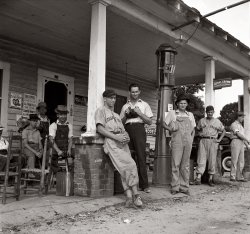
- The Simple Life: 1939
- ... western Washington. View full size. Photograph by Dorothea Lange.
Fourth kid Looks like the 4th kid is looking out the window!
... Posted by Dave - 08/13/2013 - 3:31pm -
![The Simple Life: 1939 August 1939. Three of the four Arnold children outside their farmhouse at Michigan Hill. The oldest boy earned the money to buy his bicycle. Thurston County, western Washington. View full size. Photograph by Dorothea Lange.
Fourth kidLooks like the 4th kid is looking out the window!
Thanks for all the hard work. I love this blog
This is us!From the bike, cat, kids, bare feet on dirt and rustic looks - this could be my kids on our farm now, and since an even greater depression is looking likely . . . guess we'll already be ready! :-)
No match!!during the great depression in my country 10 years ago, we sold our bike and ate the cat for dinner........am serious
Save UpFor just a few dollars more, he coulda got the model with brakes.
Spats?What are those chaps ( or spats) the big boy has on his shins? Bike guards?
[Puttees. - Dave]
(The Gallery, Bicycles, Cats, Dorothea Lange, Great Depression, Kids)](https://www.shorpy.com/files/images/8b34759u.thumbnail.jpg)
- Mother and Children in Tent Camp: 1936
- ... living in a tent camp in Nipomo, California. Photograph by Dorothea Lange, March 1936. View full size.
The mother in this photo is the ... Posted by Ken - 09/07/2011 - 8:24pm -
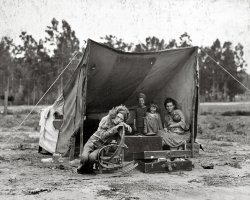
- Country Store: 1939
- ... here and here . Medium-format nitrate negative by Dorothea Lange. View full size.
NC tobacco anyone? The influence of tobacco ... Posted by Dave - 11/16/2012 - 12:39pm -
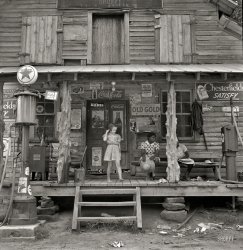
- Mississippi Cotton Patch: 1936
- ... View full size. Medium-format nitrate negative by Dorothea Lange.
Living Doesn't look like he was making much of a living.
... Posted by Dave - 07/05/2009 - 2:09am -
![Mississippi Cotton Patch: 1936 July 1936. "Old-time Negro living on a cotton patch near Vicksburg, Mississippi." View full size. Medium-format nitrate negative by Dorothea Lange.
LivingDoesn't look like he was making much of a living.
Doesn't look like cottonDoesn't look like cotton either.
[Dorothea Lange was describing where he lived, not necessarily where he was standing when the photo was taken. Although the field off to the right does look like it could be cotton. -Ken]
"cotton patch"That is sure NOT a cotton patch! anyone who was raised pickin/chopping cotton knows what one looks like.
(The Gallery, Dorothea Lange, Great Depression, Rural America)](https://www.shorpy.com/files/images/8b29633u.thumbnail.jpg)
- Dilapidated: 1936
- ... Pennsylvania. "Old age." Medium-format nitrate negative by Dorothea Lange for the Farm Security Administration. View full size.
Jeeter ... Posted by Dave - 07/05/2009 - 2:00am -
![Dilapidated: 1936 July 1936. Washington, Pennsylvania. "Old age." Medium-format nitrate negative by Dorothea Lange for the Farm Security Administration. View full size.
Jeeter LesterThis gentleman reminds me of Jeeter Lester in Tobacco Road. Sister Bessie said to Cousin Jeeter when Dude smashed up the fender on his new car: "It don't hurt the runnin' of it none!" It looks like the dilapidated porch don't hurt the settin' on it none.
Hm.I swear I used to own that chair.
The houseThat gentlemen and his house both look like they had a long and hard life ... oh the stories they could tell!
Close RaceLooks to be a close race between the life of the house and the life of its occupant. I wouldn't put my money on either one. A sad picture indeed.
Healing...A catnap in the warm sun can heal a lot of ills. Great pic.
Thanks for the reminderI just made an appointment with the termite inspector.
My retirement planHow's your IRA doing? Mine looks like this.
DialpidatedWho's dilapidated, the house or the man?
[Both. - Dave]
Bessie & DudeSister Bessie & Dude! - what great Erskine Caldwell characters - if you've never read Jeeter's story - you'll never really understand the South of the 1920s...
And, of course, Caldwell would have seen many, many similar pictures - he was married to an equally talented New Deal photographer. Hats off for your great quote!
A cautionary taleA reminder of what life was like before Social Security, Medicare, Medicaid, rural electrification, unemployment insurance, road-, bridge- and dam-building projects, and all those other "job-killing" federal programs.
(The Gallery, Dorothea Lange, Great Depression)](https://www.shorpy.com/files/images/8b29741u.thumbnail.jpg)
- Following the Cotton: 1937
- ... crop from Corpus Christi to the Panhandle." Photo by Dorothea Lange. View full size.
So Thin Oh, I would just love to sit that ... Posted by Dave - 06/17/2013 - 9:11am -
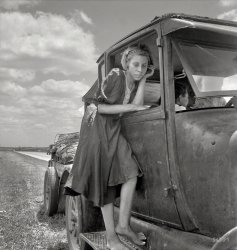
- The Cat in the Hat: 1939
- ... out of the books." View full size. Photograph by Dorothea Lange.
Today, the first installment of another selection of photos by ... Posted by Dave - 07/05/2009 - 2:41am -
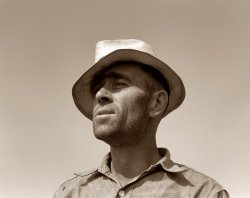
- Flat Broke: 1936
- ... tough anyway you take it." View full size. Photo by Dorothea Lange.
Then and Now It's from the toughness of these hardy folks that ... Posted by Dave - 10/05/2012 - 6:19am -
![Flat Broke: 1936 August 1936. Family between Dallas and Austin, Texas. The people have left their home and connections in South Texas, and hope to reach the Arkansas Delta for work in the cotton fields. Penniless people. No food and three gallons of gas in the tank. The father is trying to repair a tire. Three children. Father says, "It's tough but life's tough anyway you take it." View full size. Photo by Dorothea Lange.
Then and NowIt's from the toughness of these hardy folks that America is what it is. I think we have become very soft. I love this blog. And to think it was a mere 71 years ago.
There were no auto clubs orThere were no auto clubs or anyone to call these folks were on their own.
[Actually this was the heyday of the auto club. Triple A started in 1902. - Dave]
"I'm a girl!"The girl on the left is a dead ringer for Tatum O'Neal in "Paper Moon."
C'mon Dave with threeC'mon Dave with three gallons of gas left at 25 cents per gallon do you think these folks had money for an auto club?
Grapes of WrathThis is so Grapes of Wrath. This is the closest I've seen to Steinbeck's description of the Joads' car.
Yikes!Is the baby playing with a shotgun shell?
(The Gallery, Dorothea Lange, Great Depression, On the Road)](https://www.shorpy.com/files/images/8b29790u.thumbnail.jpg)























